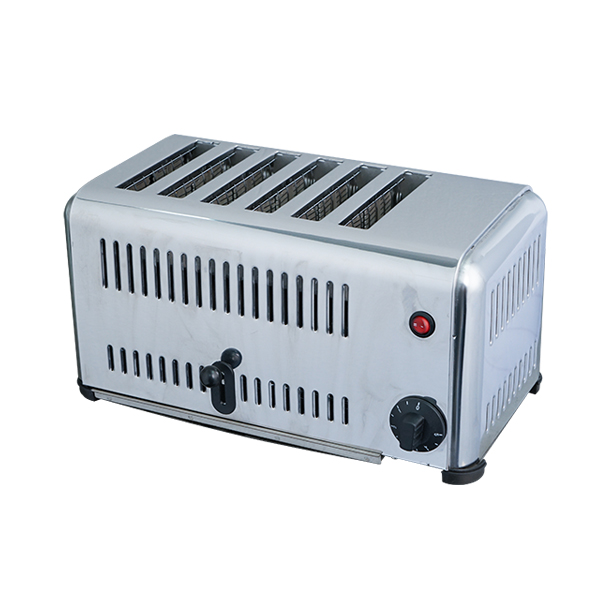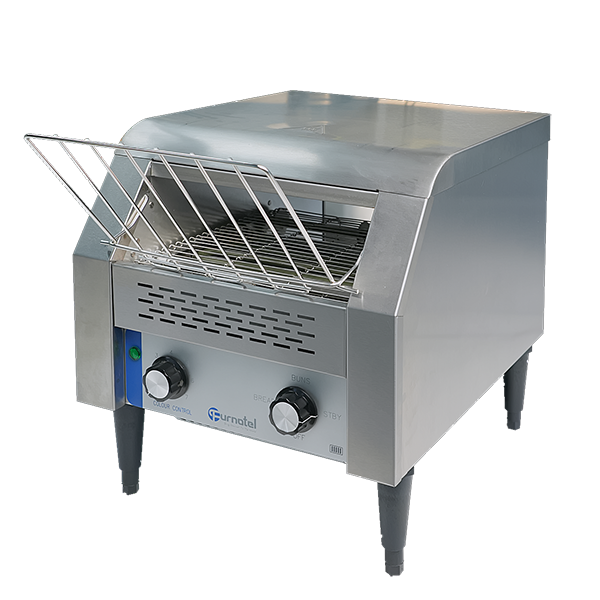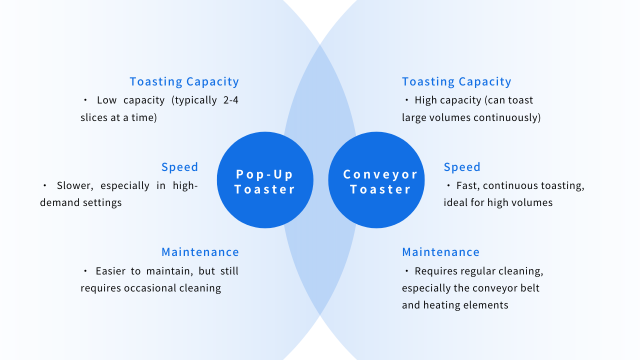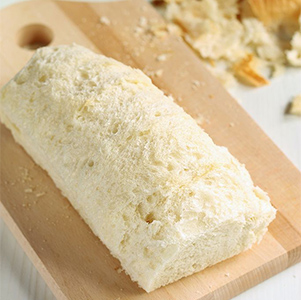When it comes to essential commercial kitchen equipment for self-service restaurants, commercial toasters are a top choice!
Difference between a pop-up toaster and a conveyor toaster
When it comes to essential commercial kitchen equipment for self-service restaurants, commercial toasters are a top choice! Among the vast array of options, we're focusing on two classic models: the conveyor toaster and the pop-up toaster. This guide will help you decide which one is the perfect fit for your establishment. Though both serve the noble purpose of toasting, their paths diverge in size, operation, and application. Whether you're managing a bustling hotel, a trendy restaurant, or a cozy café, the choice between a conveyor and a pop-up toaster can significantly impact your service.

How They Work
Pop-up toasters operate through a simple mechanism: bread slices are inserted into the slots, and heating elements toast them from both sides. When the toasting process is complete, the toaster automatically pops the bread out, signaling that it's ready to be served. Most models are equipped with adjustable browning controls, allowing users to customize the toast's level of crispiness. These toasters are generally powered by electric heating elements and have built-in timers to control the toasting duration.
Benefits of a Pop-Up Toaster
One of the primary advantages of a pop-up toaster is its simplicity. Pop-up toasters are easy to operate, making them ideal for fast-paced environments that require a quick turnaround such as hotel cafeterias, cafes, and more. The automatic ejection system ensures consistency in the toasting process, while the compact size allows them to fit easily into any kitchen setup. They are often more energy-efficient compared to other toasting methods, using less power for short bursts of time. Additionally, pop-up toasters are typically affordable, offering great value for establishments on a budget.
Drawbacks of a Pop-Up Toaster
Despite their simplicity, pop-up toasters do come with a few limitations. Their toasting capacity is generally smaller compared to other models, meaning they may not be suitable for high-volume establishments where large quantities of toast are required at once. Furthermore, the speed of the toasting process can be slower in comparison to conveyor toasters, as only a limited number of slices can be toasted at one time. Maintenance is also a consideration, as crumbs and debris can accumulate, requiring regular cleaning to ensure optimal performance.
Ideal Environments for Pop-Up Toasters
Despite the limitations, pop-up toasters excel in environments where speed, simplicity, and compactness are key. They are perfect for establishments with moderate toast demand or those that offer a self-service-style breakfast buffet. Small cafés, inns, and quick-service restaurants that serve a limited breakfast menu benefit from their straightforward operation. They shine in settings where kitchen space is at a premium and where the volume of toast doesn't justify the use of larger, more complex equipment. For businesses focusing on quick and efficient service, the pop-up toaster is often a reliable, no-frills solution.
Considerations for Buying a Pop-Up Toaster
When purchasing a pop-up toaster for your commercial kitchen, it's essential to evaluate your specific needs. If your café, bakery, or hotel kitchen experiences high foot traffic, a pop-up toaster may not meet your volume requirements, and you may want to consider other commercial kitchen equipment options, such as a conveyor toaster. For smaller operations or those with moderate toast volume, however, pop-up toasters are a great choice. Look for models with durable stainless steel exteriors, adjustable heat settings, and easy-to-clean crumb trays. These features ensure longevity and reliable performance in busy hotel kitchen solutions or bakery equipment setups. Don't forget to check for warranties to safeguard your investment.

How They Work
Conveyor toasters operate by feeding bread through a conveyor belt that moves through heated elements. The bread slices are placed at the input end of the belt and travel through the toaster to the output end, where they are toasted to perfection. The speed of the conveyor and the intensity of the heat can be adjusted based on the type of bread and the desired level of crispiness. This continuous toasting method ensures uniform results, making conveyor toasters ideal for commercial kitchens that need to produce consistent, high-quality toast in large quantities.
Benefits of a Conveyor Toaster
The primary benefit of a conveyor toaster is its high throughput. These toasters can handle large volumes of bread at once, making them ideal for busy kitchens that serve many customers quickly. Their continuous operation ensures that multiple slices can be toasted simultaneously, reducing wait times and improving efficiency. Consistency is another key advantage, as the conveyor system ensures even toasting from edge to edge. Conveyor toasters are versatile and can toast a variety of items, from regular bread to thicker slices and even frozen items. Additionally, they are more energy-efficient than other high-volume toasters, as they are designed for prolonged use without overheating.
Drawbacks of a Conveyor Toaster
While conveyor toasters are highly efficient, they come with some drawbacks. One major consideration is the higher initial cost compared to pop-up toasters, which may be a concern for smaller establishments with limited budgets. They also require more counter space due to their larger size and the conveyor belt system. Regular maintenance is needed to keep the conveyor belt clean and prevent buildup of crumbs and grease. Additionally, since conveyor toasters operate at higher temperatures for longer periods, they consume more energy than smaller models, which may affect long-term operating costs.
Considerations for Purchasing a Conveyor Toaster
When purchasing a conveyor toaster, it's important to consider your kitchen's volume needs. High-demand environments, like buffets or large restaurants, will benefit from the continuous toasting capability. Choose a model with adjustable speed controls and temperature settings to ensure flexibility in toasting different types of bread and baked goods. Durability is critical, so look for toasters made with high-quality materials like stainless steel, which can withstand heavy use. What's more, learning how to troubleshoot a conveyor toaster is part of extending its life. Additionally, consider the machine's energy efficiency and ease of cleaning, as regular maintenance will ensure the toaster's longevity and consistent performance in a commercial setting.

Safe Cleaning and Crumb Removal
Maintaining a clean toaster is crucial for both performance and food safety. Regular crumb removal prevents buildup, reduces fire hazards, and ensures consistent toasting. Both pop-up and conveyor toasters should be cleaned after each use to remove crumbs and grease. For conveyor models, the conveyor belt and heating elements require frequent cleaning to maintain optimal efficiency. Choosing toasters with removable crumb trays or easy-to-clean surfaces can significantly reduce maintenance time and keep your equipment running smoothly in high-demand commercial environments like hotel kitchens or restaurants.

The Future of Toasting
The future of commercial toasters is evolving with technological advancements that promise greater efficiency and versatility. Smart toasters with digital controls and preset programs are already entering the market, allowing for precise adjustments in temperature, speed, and toasting time. Energy-efficient models and sustainability are becoming more prominent, addressing both operational costs and environmental concerns. In the coming years, we can expect even more innovations in commercial kitchen equipment that will make toasting faster, more consistent, and more eco-friendly, catering to the dynamic needs of modern food service operations.
Conclusion
Choosing between a pop-up toaster and a conveyor toaster ultimately depends on the specific needs of your commercial kitchen. For smaller, lower-volume establishments, a pop-up toaster may be the right choice, while high-traffic kitchens benefit more from the efficiency of a conveyor toaster. At Shinelong, we provide a wide range of commercial kitchen solutions, including durable, high-performance toasters designed to meet the needs of various food service environments. Whether you're running a café, a hotel, or a large buffet, our equipment ensures reliable performance and ease of use, helping you elevate your kitchen operations.
- What are the different types of toasters?There are 3 major styles: pop-up toasters, Conveyor Toasters & Toaster Ovens
- Is a higher wattage toaster better?Higher-wattage toasters can toast faster and more evenly, especially for thicker slices, but they also consume more energy. It's better if you need quick toasting or handle thicker bread, but for energy efficiency, lower wattage models can be more suitable
- Is it worth spending more on a toaster?It depends on your needs: speed, quality, and budget.

Since Shinelong was established in Guangzhou in 2008, we have made great strides in the fields of commercial kitchen planning and kitchen equipment manufacturing.
IF YOU HAVE ANY QUESTION,PLEASE CONTACT US.
WhatsApp: +8618902337180
WeChat: +8618924185248
Telephone: +8618924185248
Fax: +86 20 34709972
Email: info@chinashinelong.com
Add: No. 1 Headquarters Center, Tian An Hi-tech Ecological Park, Panyu Avenue, Guangzhou, China.


















